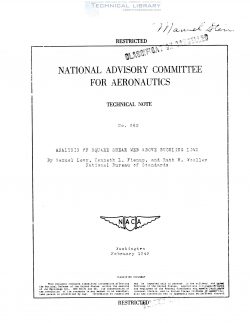naca-tn-962
- Version
- 61 Downloads
- 2.57 MB File Size
- 1 File Count
- December 1, 2016 Create Date
- December 1, 2016 Last Updated
National Advisory Committee for Aeronautics, Technical Notes - Analysis of Square Shear Web Above Buckling Load

A solutiOn of Von Karman's fundamental equations for
plates with large deflections is presented for the case of
a shear web divided into square panels by reinforcing struts.
Numerical solutions are given for struts of infinite rigid—
ity and for struts the weight of which is one—fourth the
weight of the sheet. The results are compared with Wagner's
diagonal tension theory as extended by Kuhn and by Lnnghaar.
It is found that the diagonal tension theory as developed by
Kuhn agrees best with the present paper in the practical
range when r = 1/4, Kuhn's theory is in especially good
agreement for the force in the strut when r = 1/4.
The necessity for designing structures having the
smallest possible weight for a given lOad has forced air~
plane designers to build wing—beams and monoc0quc boxes
with sheer webs so thin that they may be buckled in a di-
agonnl direction under service loads. As the shear load is
increased well above the buckling lead, it is carried prin—
cipally by diagonal tension along the buckles, The beam
approaches a "diagonal-tension field" beam.
The lOad at which such shear webs will buckle has been
determined by several authors. (See, for example. pp. 357
to 568 of reference 1,) After buckling, the behavior of
the web is frequently determined frOm Wagner's diagonal—
tension—field theory (references 2 and 3) which neglects
the flexural rigidity of the sheet, Experimental results
(see p, 2 of reference 4, pp. 18 and 19 of reference 5, and
p. 5 of reference 6) indicate that Wagner's diagOnal—tension—
field theory may be too conservative for constructions in
which the diagonal tension field is only partially develOped.
An analysis of the behavior of a flat plate subjected
to shearing loads covering the range from the start of buck~
ling to the development of a full diagonal tension field was
therefore, thought desirable. Such an analysis, based 0n 2
Karman‘s large deflection equations' was made for the case or
a shear web divided into square panels by vertical struts.
| File | Action |
|---|---|
| naca-tn-962 Analysis of Square Shear Web Above Buckling Load.pdf | Download |
Comment On This Post